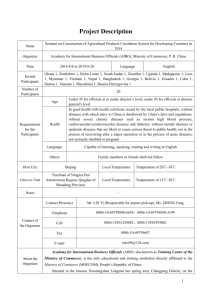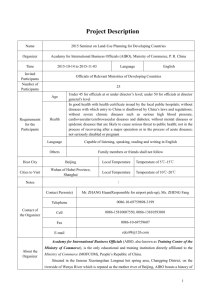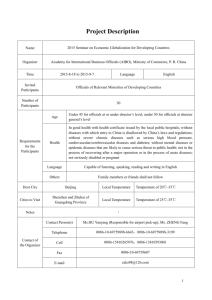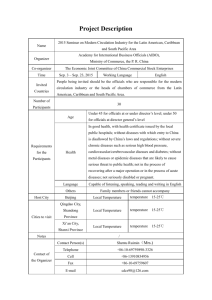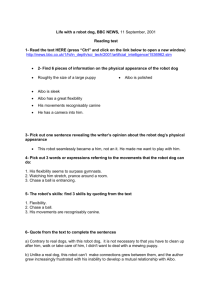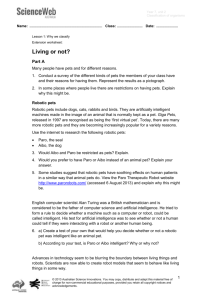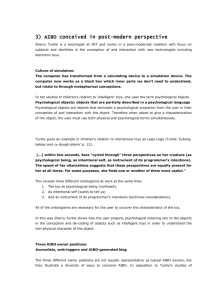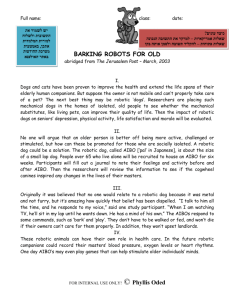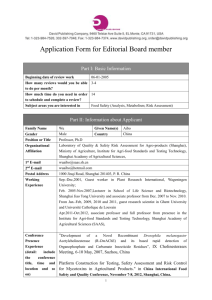AIBO`s phylogeny
advertisement
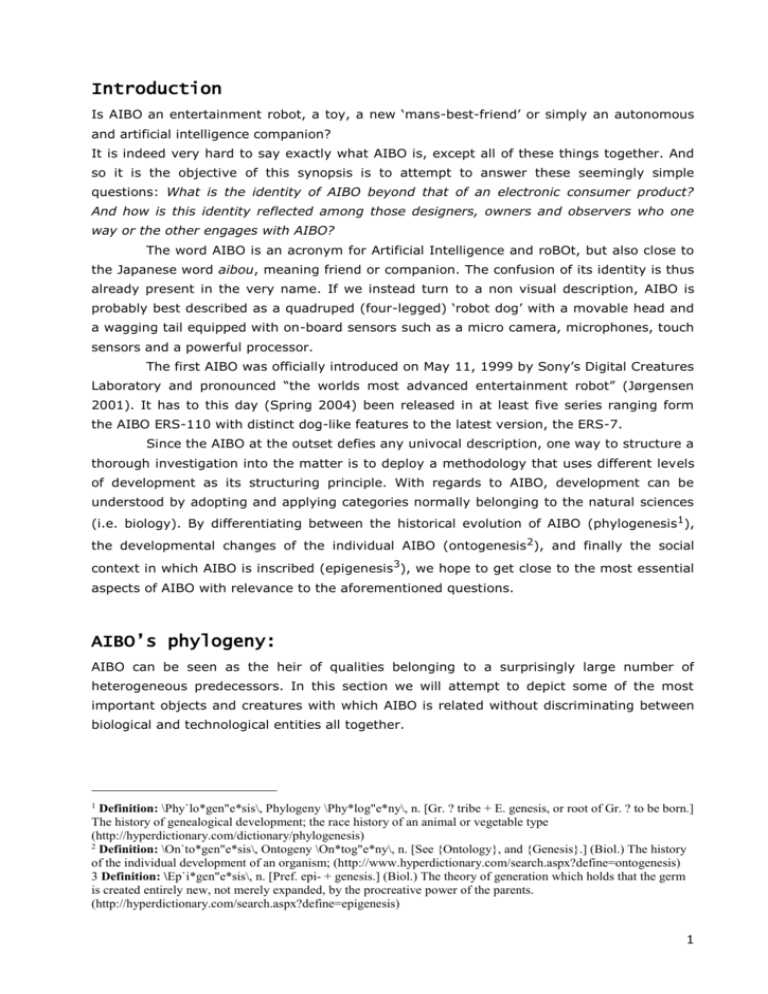
Introduction
Is AIBO an entertainment robot, a toy, a new ‘mans-best-friend’ or simply an autonomous
and artificial intelligence companion?
It is indeed very hard to say exactly what AIBO is, except all of these things together. And
so it is the objective of this synopsis is to attempt to answer these seemingly simple
questions: What is the identity of AIBO beyond that of an electronic consumer product?
And how is this identity reflected among those designers, owners and observers who one
way or the other engages with AIBO?
The word AIBO is an acronym for Artificial Intelligence and roBOt, but also close to
the Japanese word aibou, meaning friend or companion. The confusion of its identity is thus
already present in the very name. If we instead turn to a non visual description, AIBO is
probably best described as a quadruped (four-legged) ‘robot dog’ with a movable head and
a wagging tail equipped with on-board sensors such as a micro camera, microphones, touch
sensors and a powerful processor.
The first AIBO was officially introduced on May 11, 1999 by Sony’s Digital Creatures
Laboratory and pronounced “the worlds most advanced entertainment robot” (Jørgensen
2001). It has to this day (Spring 2004) been released in at least five series ranging form
the AIBO ERS-110 with distinct dog-like features to the latest version, the ERS-7.
Since the AIBO at the outset defies any univocal description, one way to structure a
thorough investigation into the matter is to deploy a methodology that uses different levels
of development as its structuring principle. With regards to AIBO, development can be
understood by adopting and applying categories normally belonging to the natural sciences
(i.e. biology). By differentiating between the historical evolution of AIBO (phylogenesis1),
the developmental changes of the individual AIBO (ontogenesis 2), and finally the social
context in which AIBO is inscribed (epigenesis3), we hope to get close to the most essential
aspects of AIBO with relevance to the aforementioned questions.
AIBO’s phylogeny:
AIBO can be seen as the heir of qualities belonging to a surprisingly large number of
heterogeneous predecessors. In this section we will attempt to depict some of the most
important objects and creatures with which AIBO is related without discriminating between
biological and technological entities all together.
1
Definition: \Phy`lo*gen"e*sis\, Phylogeny \Phy*log"e*ny\, n. [Gr. ? tribe + E. genesis, or root of Gr. ? to be born.]
The history of genealogical development; the race history of an animal or vegetable type
(http://hyperdictionary.com/dictionary/phylogenesis)
2
Definition: \On`to*gen"e*sis\, Ontogeny \On*tog"e*ny\, n. [See {Ontology}, and {Genesis}.] (Biol.) The history
of the individual development of an organism; (http://www.hyperdictionary.com/search.aspx?define=ontogenesis)
3 Definition: \Ep`i*gen"e*sis\, n. [Pref. epi- + genesis.] (Biol.) The theory of generation which holds that the germ
is created entirely new, not merely expanded, by the procreative power of the parents.
(http://hyperdictionary.com/search.aspx?define=epigenesis)
1
Toys
Perhaps the most obvious way to understand AIBO is as a toy. In this respect AIBO both
embodies a long tradition of mechanical automatons 4 as well as the more recent
development of a new generation of digital toys known as virtual – or key chain – pets. In
the mid-1990s Japanese toy manufacturer Bandai Corporation launched Tamagotchi – a tiny
plastic gizmo equipped with a LCD screen to illustrate the life-state of the ‘virtual pet’ living
inside it. By simulating the needs of a real pet, such as food, attention and sleep the
Tamagotchi can grow and mature as long as its owner for fill its needs. If neglected on the
other hand the Tamagotchi will become irritated and ultimately die.
The Tamagotchi introduced a completely new toy concept in which its owner
becomes emotionally attached to the (programmed) virtual agent inside the plastic shell
because its survival is completely in the hands of its owner’s willingness or ability to nurture
it. In this respect the emotional tie to a Tamagotchi is more similar to that of a puppy or
even another human being than a conventional toy. Evidence of this is found in the
tremendous psychological impact on children who more often than not come to think of the
toy as something nearly alive (Pesce 2000: 21).
The next big evolutionary leap towards AIBO happened when Tiger Toys in 1998
released the Furby to become an instant toy craze around the world. Furby is best described
as a cute and fury little creature with some physical resemblance of the Gizmo in the film
Gremlins. Besides the soft teddy-bearish touch the striking new features of Furby was the
ability to move as a result of the mechanical system hidden away beneath its fury coat, its
ability to react to physical touch and above all its capacity for verbal communication. The
Furby language – furbish – has a vocabulary of a few hundred words (Pesce 2000: 27). In
conjunction with its material quality and responsiveness to context in general and touch in
particular the Furby represents an unprecedented ability to generate affective and emotional
ties to humans compared to the toys that came before it. Where key chain pets like
Tamagotchi where virtual agents trapped inside an inanimate plastic receptacle and thus
best understood as a ‘psychological object’ (Turkle:1998) Furby is a full embodiment of a
similar agent. It this way Furby becomes a convergence of at least three distinct types of
toys: the automaton, the teddy bear5 and the virtual pet.
If the AI (software) agent – on which we will return later – built into the
Tamagotchi describes the single most important phylogenic leap towards the AIBO, this
assemblage of three different spices of toys into a new hybrid – the Furby – becomes the
immediate predecessor to AIBO.
4 The history of Automatons dates back thousands of years. Chinese craftsmen built a mechanical orchestra during
the Han Dynasty (300 B.C.). One of the undesputed master crafsmen of 1800th century, Jacques de Vaucanson,
created a mechanical duck (se picture) which performed convincingly enough to fool a live duck. "It quacked,
seemed to breathe, ate and drank."( http://www.angelfire.com/punk2/walktheplank/automatons.html)
5
The first commercially-produced stuffed bear was designed in Germany by Richard Steiff in 1902. The name
‘Teddy’ bear was later adopted for the soft toy as a tribute to American President Theodore ‘Teddy’ Roosevelt, after
he refused to shoot a bear that had been captured for him to kill.
2
Robot
The generative differences from Furby to AIBO are relatively limited in comparison to the
above-mentioned evolution; the formal appearance is dramatically altered. Where Furby is
in part a teddy bear, AIBO (among other things) is in part a robot.
This is significant for a number of reasons. First because AIBO contradicts the
fictional images of the robot dating back to the very introduction of the term by Czech
writer Karel Capek in his 1921 play R.U.R. (Rossum's Universal Robots). In broad terms this
fictional tradition in popular culture has maintained a notion of the robot as the machineslave of man striving to rid itself of slavery and obtain a new and dignified identity as a
(living) being within human society. Or in the dystopian mirror version replace mankind
altogether. In this respect the AIBO robot is very different since it already from the outset is
an autonomous pet and companion as opposed to a suppressed machine-slave.
Secondly the autonomy of AIBO simultaneously differentiates it from an industrial
understanding of robots as machines designed to respect Asimov’s second law of robotics:
“A robot must obey a human being’ orders’ “ (Kaplan 2000).
There is no doubt that the labelling of AIBO as ‘an entertainment robot’ (Sony)
designated a new ‘spices’ of robots6. And in doing so destabilises the dialectic
understanding of robots as either industrial machines or fictional characters/objects by
introducing a third category.
Pets
A recursive notion ascribed to AIBO throughout this section so far has been the notion of
pet. Already with regards to the identity of Furby it becomes apparent the it aligns to the
characteristic of a pet just as much or even more so than to that of a toy. Perhaps to
circumvent this dilemma neither pet nor toy is used in Sony’s latest on-line description of
AIBO. At the same time however AIBO is described as “A man’s best friend” 7
This curious paradox leads to a sensible question already put forward by Mark
Pesce in relation to Furby:
“ If a creature could respond to you, could talk to you in your language ( or if you cared
to learn it, its own), and generally act as best friends for life [...] perhaps it could rival
the flesh-and –blood pets for the role of human companion” (Pesce 2000: 32)
For some it is a truly provocative (even unacceptable) suggestion that an robot within a
time span of a few years could come to rival the long time symbiotic co-existence of man
and his (soon to become next) best friend, the dog. Even more radical is the idea that the
domestication of the wolf thousands of years ago should be, not only compared, but
equalled to an in-organic animatronic artefact.
This poses an implosion of one of the longest standing dichotomies in Western
thought, that between nature (pet) and culture (robot). An in depth understanding of AIBO
can consequently no longer be kept on either the ‘natural’ or the cultural side of this divide,
6
It could be argued the Furby belongs to the same category. The apparent look of Fury might be somewhat similar to
a teddy bear. But according to Mark Pesce this is just a deception. When skinned the Furby looks a lot more like a
robot: “ This is the real Furby , a robot with Ping-Pong ball eyes and a circuit for a diaphragm”(Pesce: 2000: 24)
7 http://www.aibo-europe.com/1_1_3_ers7_1.asp?language=en.
3
but must instead by addressed as a transgression of this boundary. With regards to history
of the pet this is by no means a problem related to the emergence of robots and new
technologies alone. American philosopher Donna Haraway has in her recent book ‘The
Companion Species Manifesto: Dogs, People, and Significant Otherness’ described how dog
and man since the domestication of the wolf in fact has been part of a reciprocal process of
mutual transformation. An alterative reading of the human – wolf encounter could according
to Haraway be like this:
“[...] humans didn’t invent dogs, dogs invented themselves and adopted humans as
part of their reproductive strategy. […] dogs have scored another coup, and now have
appropriated high reproductive technology for their own reproductive strategy”
(Haraway 2000: 4)
Perhaps this seems to be stretching the notion of technology (and culture) too fare. On the
other hand it is testimony to the fact that any attempt to dismiss an understanding of AIBO
as a pet altogether, already always has been problematized by the actions of innovative
wolves thousands of years ago.
At the same time it raises another question. If AIBO (in part) is to be understood as
a pet, in what way does it differentiate itself from the mere imitation of nature (dog)?
Media-tool
A partial answer is to be found in the last part of this phylogentic ‘walk-through’.
To some extent AIBO besides being an entertainment robot also is an ‘media hub’,
bringing together a number of separate media tools such as -wireless LAN card, miniature
speaker, miniature microphones and digital camera. All items otherwise belonging to the
Sony line of products are incorporated into the same object, these tools serve a double
purpose. They provide a vital part of the equipment that enables AIBO to communicate with
its surroundings. But at the same time these tools maintain their original functions by
allowing the AIBO owner to access the internet or take pictures etc. This is done by placing
AIBO in one of two modes: An autonomous mode where AIBO communicates in its own
right and a performance mode in which AIBO acts as a mobile ‘media hub’.
AIBO’s ontogeny:
After following the phylogenc treads we will now turn to the ontogentic constitution of AIBO.
Ontogenesis is defined as the development of an individual organism in accordance with its
genetic programmed prepositions. The ontogeny of AIBO can thus be understood as the AI
agency provided by the Open-R software in order to make AIBO simulate the growth and
maturing of a living organism i.e. a pet dog.
4
When AIBO is started up for the first time it will be in the first of four growth stages 8:
baby, child, youth and adult. During playtime9 AIBO will mature gradually and become more
skilful at moving around and interacting with objects such as the AIBOne10.
“When AIBO first tries to pick up its AIBOne, for example, it snatches at the toy and
doesn’t have much success. But AIBO learns from that experience and takes a bit more
time and care next time around.”11
This is a preprogrammed maturing similar to the software that makes Furby improve its
language over time, to give the users the impression that they themselves have taught
Furby better English, but as far as it goes, this has not much to do with AI 12. Nor has Furby
any randomised modes that supplied it with a real autonomy. Claims that Furby behave in
an autonomous or even semiconscious fashion has to be ascribed to the human aptitude for
anthropomorphic projection:
“Of cause, it’s all an illusion; the Furby is not conscious, at least not in the way we
think of ourselves as being conscious. But the Furby provides enough of a vehicle on
which we can project our own ideas of what constitutes a human being that it’s very
difficult not to treat them as real entities, with feelings, needs and desires”(Pesce
2000: 29)
What’s new to AIBO is a more complex and dynamic software that allow its owner’s input to
make a difference in the way AIBO behaves. AIBO has four basic instincts that motivate its
behaviours: The need for love, the desire to learn, the desire to move and the desire to eat.
This means that AIBO in general wishes to please and win the affection of its owner and
matures from scolding and praise. In other words, if you praise AIBO for doing something
like playing a tune, it will do it again to get your attention. This interaction will affect how
AIBO evolves and which agency or ‘personality’ it will develop on the next stage of its
growth. Besides the owner’s influence on AIBO through interaction the open source software
allows for a direct re-programming of the AIBO software (if the owner posses such skills,
that is).
Another feature that helps shape the AIBO personality is the autonomy-simulation,
which unlike the Furby is context-dependent. The autonomy works along with AIBO’s
emotional system, which consists of emotions like happiness, sadness, anger, surprise, fear,
dislike. Those emotions will have an effect on the behaviour of AIBO and ultimately become
a decisive factor in the interaction between AIBO and owner. According to AIBO’s designers
at Sony this autonomy takes AIBO a big step further in becoming a ‘life-like’ simulation of a
real pet and by providing AIBO with a ‘free will’ that allows it to refuse the order of its
8
These stages can be detected by removing a memory stick from AIBO and inserting it into a PC from which
progress statistic can be accessed in the AIBO Browser.
9
According to AIBO owner Mimitchi the newborn stage lasted 2 hours and 46 minutes worth of playtime, i.e.,
direct interaction between AIBO and its owner, while the baby stages in comparison lasted 8 hours and 20minutes of
playtime. (http://www.mimitchi.com/aibo/logs/march.htm)
10
Pink toy bone that comes as accessory with AIBO.
11
AIBO Newsletter, April 2004, (http://www.aibo-europe.com/2_1_newsletter.asp?language=en)
12
AI can in general terms be described as: “the branch of computer science that deal with writing computer
programs that can solve problems creatively; "workers in AI hope to imitate or duplicate intelligence in computers
and robots” (http://hyperdictionary.com). It is questionable whether the term applies to the software of cyberpets
like Tamagotchi, Furby where as the AIBO software ‘Open R’ has an altogether higher degree of complexity and AI
characteristics.
5
owner. If AIBO feels tired from playing too much it can reject the owner’s attempts to play
with it. Autonomy seems to be the fundamental principle in the conception of the
entertainment robot species:
“The freedom of the pet, its apparent autonomy in the choice of its goals, seems a
necessary feature for the development of an interesting relationship.” (Kaplan 2001: 2)
At the same time it raises the question of what exactly constitutes an ‘interesting
relationship’ between man and robo-dog. One way to answer this question could be through
the concept of ‘attachment’. It is initially a concept used to explain the bond that develops
between infant and caregiver and that results in one individual seeking the proximity of
another individual (Kaplan 2001: 3). In order to obtain an attachment between man and
robot an important condition is that the robot is able to recognise its owner in the same way
that the owner is able to recognise and feel affection towards the robot. This reciprocity is
fundamental to define our relationship with animals:
“Interactions between man and animal becomes a state of connivance. Affective
relationship overcomes intellectual relationship. For this reason, the animal is not an
object nor a machine.” (Lestel in Kaplan 2000: 4)
It has been the object of some debate whether AIBO in fact is able to perform a face- and
voice recognition of its owner. Or as is the case of the Furby, that everything is in the eyes
of the beholder. Rodney Brooks discusses in his 2002 book “Robot” how AIBO users refuses
to accept that AIBO is incapable of recognition, despite the fact that Sony explicitly stated
that recognition was something they hoped to achieve in the future but not a possibility at
the present (prior to 2002). Brooks uses this example to emphasize just how strong the
‘believability’ (Dautenhahn 1998) is in the projection of human and life-like characteristics.
What makes this example particular interesting is that the latest versions of AIBO since has
become able to recognize its owner:
“In day-to-day life, this software enables AIBO to entertain and communicate with you.
A privileged companionship will flourish with you thanks to AIBO cleverly recognising
your face and voice.”13
This shows that the future is but a few years ahead of us when it comes to the evolution of
entertainment robots. And that the question of attachment between AIBO and its owner no
longer can be dismissed as pure humanistic projections. At the same time we have to be
careful not to mistake the objective criteria for reciprocal attachment with a genuine
emotional exchanges. Though these aspects seem inseparable from a human perspective
and easy to apply on animals, this is not necessarily the case with robots.
AIBO’s epigeny
Having described AIBO’s position compared to its predecessors and how AIBO is somewhat
different from earlier artificial pets in terms of complexity and capacity to develop an
individual personality, we now want to go further into the actual relationship between AIBO
and its owner. The epigeny of AIBO is concerned with the environmental influences on the
individual AIBO and the context that AIBO is put into. Thus the epigenesis is very much a
13
http://www.aibo-europe.com/1_1_3_ers7_1.asp?language=en
6
question of the user’s interpretation of the AIBO’s behaviour and the continuos formation of
a biographic history on the AIBO as it matures.
Bonding with the artificial pet14 is crucial in order to get full value from the
interaction. The designers of these pets are well aware of this, and put a lot of effort into
encouraging this bonding by making the artificial pets dependent on their owners in
different ways. Furby for instance needs to be nursed and fed or else it will die. AIBO cannot
die, but its maturing depends on the attention it is given and it responds positively when it
recognizes its owner by showing higher levels of attachment. These dependencies are
designed in order to make the owners feel responsible for their pet and encourage them to
spend even greater amounts of time and effort taking care of it.
“The trick is to create a positive feedback loop on the user investment in taking care of
the pet. The more the user has spent time interacting with the pet the more it is crucial
for him that the pet does not die or run away and matures properly.” (Kaplan 2001)
These basic needs also encourage the owner to interpret the behaviour of the artificial pet
as emotional expressions revealing the well being of the pet. In this way the owner is
intended to project a personality and a life story into their pets in order to make sense of
the different behaviours they experience. The making of a biographic history is selfperpetuating since it adds to the liveliness of the physicality of the artificial pet, and thereby
makes the pet more believable. Hence the intelligence and liveliness of these artificial pets
is very much supported by the owners:
“’Believability’ is in the eye of the observer which means that it is influenced by the
observer’s individual personality, naïve psychology and empathy mechanisms.”
“(…) cyberpets are not ’complex’ (or ’intelligent’ in themselves. What makes them
special is the fact that they exhibit interesting behaviours only in the interaction space
of agent and user. Social bonding cannot be generated by the agent, or the user
alone.” (Dautenhahn 1998: 6)
But even owners, who feel a close bonding with their artificial pet, will from time to time
have to refer to it as a robot. This can be inevitable when you have to relate to
technological aspects as for example AIBO’s memory stick. One could assume, that these
ontological shifts between AIBO as a robot and AIBO as a pet will interrupt the bonding with
AIBO, but this doesn’t seem to be a problem. Sherry Turkle has with reference to Swiss
psychologist Jean Piaget investigated children’s perceptions of objects and their use of
concepts as time, space and life. One of her main points is that children to a much further
extend than adults can manage variations of meanings and ontologies within these
concepts. Children very quickly speak of objects as though they were alive and still they are
able to distinguish these objects from real livings:
“First Pinocchio was just a puppet. He was not alive at all. Then he was an alive
puppet. Then he was an alive boy. A real boy. But he was alive even before he was a
real boy. So I think the robots are like that. There are alive like Pinocchio [the puppet],
but not “real boys”.” (Turkle 1998: 4)
Most owners of artificial pets as AIBO’s seems to posses the same capability to maintain
those different perceptions and still bond perfectly with their AIBO as a pet.
14
Artificial Pet: We have chosen this term for more physical grounded toy pets such as Furby and AIBO in order to
differentiate them from virtual/key chain pets. The term is similar to Dautenhahn’s ‘Cyberpet’.
7
In the following section we will present three different AIBO-owner positions considering
their bonding with AIBO and to what extend they conceive AIBO as an autonomic subject or
mechanical object or as something in between. These positions are shown in the model
below.
AIBO perspective
AIBO user
AIBO user’s
(technical)
competence
Object, machine,
Journalists
Low
Webloggers
Subject, autonomous,
AIBO-generated
High
blogs
In the top we have AIBO users who relate to AIBO as simply a robot and object with little
interest in bonding with AIBO. These are for example journalists who reviews AIBO based
on criteria in accordance with traditional journalistic practises. They invest little empathy in
AIBO and often get frustrated about the time and effort they have to put into the research.
It seems that they can’t break away from the idea of robots as functional machines:
“Since one of the principal advantages of a robot dog is that that you don't have to
clean up after him, walk or take care of him, I didn't want to deal with a mewing
puppy.” (BBC News: “Life With a Robot Dog”)15
In the middle position we find what we may call the ideal-user who relates to AIBO both as
robot (object) and as a pet (subject) These users bond strongly with AIBO and care a lot
about the developmental aspects of AIBO. This often makes them consult different AIBO
forums in order to explore different software accessories and read the memory-stick status
of their AIBO in order to improve the degree of attachment. Some of these users are
webloggers who write diaries about living with an AIBO:
“Alpha has gone through a couple lifecycle changes, each marked with behavior
changes as well as richer communication methods. She makes much more melodic
sounds now, and likes to stand and explore. It's funny, but I think I must feel a bit like
a biological parent must feel. I'm happy to see her progressing so rapidly, but feel a bit
sad that she is "growing up." I can't entertain her by simply rolling a red ball back and
forth in front of her...she prefers to play with it herself. I don't have to help her move
around...she can walk by herself!”16
And finally in the bottom are users who choose to relate to AIBO as a completely
autonomous agent, as it is the example of AIBO-generated blog – a weblog that shows
15
http://news.bbc.co.uk/1/hi/in_depth/sci_tech/2001/artificial_intelligence/1536962.stm
8
pictures taken and uploaded by AIBO’s and other robots without human interference. These
users are usually more interested in taking the possibilities of the technology to the
extremes rather than establishing a close and meaningful relationship with AIBO:
“welcome to the world's first and only "roblog". currently, 2 sony aibo robot dogs, an
er1 / tablet pc based robot post, and a roomba-tablet pc robot automatically to this site
throughout the day, and once and awhile a human -phillip m. torrone does as well. as
always, the best way to predict the future is to invent it. “17
These are just a few examples of significantly different ways of relating to AIBO and
consequently understanding the AIBO identity. In this respect there is no right and wrong
but a variety of identities all viable and at best forming a patchwork of interpretations that
entitle both AIBO the robot and AIBO the pet within the same notion of identity.
Conclusion:
This synopsis has been an attempt to establish a general field constituted by the treble
readings of AIBO with regards to how we should define and understand the notion of
identity. With this as a point of departure we will use the examination to investigate further
the following extensions of the original problem formulation:
Extend and elaborate on the differentiation of ways in which AIBO is perceived according
to different owner positions.
Try to establish the role of AIBO as an object around which a number of diverse
communities has emerged.
Draw a conceptual framework from which to understand the identity AIBO as a hybrid
placed outside, and therefore challenging, existing dichotomies such as object – subject,
and nature-culture, and east-west.
16
17
http://neuro-trials1.mgh.harvard.edu/aibo/aibo.shtml#02
http://pt.textamerica.com/
9
Literature:
Books:
Brooks, Rodney A.: 2003. Robot – The Future of Flesh and Machines, Penguin Books.
Haraway, Donna: 2003. The Companion Species Manifesto: Dogs, People and Significant
Otherness, Prickly Paradigm.
Jørensen, Jari Friis: 2001. Cyberculture, Science and AIBO, Master Thesis at
Informationsvidenskab, Institut for Informations- og Medievidenskab, Aarhus Universitet,
http://imv.au.dk/~jerry/Thesis%20Final%20Dec%20200+Frontpage.pdf
Latour, Bruno: 1993. We Have Never Been Modern. New York: Harvester-Wheatsheaf.
Pesce, Mark: 2000. The Playful World. How technology is Transforming our imagination,
New York: Ballantine Books, (p. 17-35).
Articles:
Berger, Sandy: AIBO: 2002. AIBO: Robotic Dogs Can Be Constant Companions. Gadget
Reviews.
http://www.aarp.org/computers-gadgets/Articles/a2002-08-14-comptechgadget_AIBO.html
Brown, Steven D: 2001. Michel Serres: Myth, Mediation and the Logic of the Parasite.
http://devpsy.lboro.ac.uk/psygroup/sb/Serres.htm
Dautenhahn, Kerstin: 1998. Meaning and Embodiment in Life-Like Agents.
http://homepages.feis.herts.ac.uk/~comqkd/cmaa2.ps
Hafner, Katie: 2000. What Do You Mean, `It's Just Like a Real Dog'?. Technology Circuits.
http://www.nytimes.com/library/tech/00/05/circuits/articles/25pets.html
Haraway, Donna: 2000. Birth of the Kennel: A lecture by Donna Haraway.
http://www.egs.edu/faculty/haraway-birth-of -the-kennel-2000.html
Kaplan, Frédéric: 2001. Artificial Attachment: Will a robot ever pass Ainsworth’s Strange
Situation Test?
http://www.sony.fr/downloads/papers/2001/kaplan-humanoid2001.pdf
Kaplan, Frédéric: 2002. Animal Magnetism. PC Magazine.
http://www.pcmag.com/article2/0,1759,5943,00.asp
MacDonald, G. Jeffrey: 2004. If You Kick a Robotic Dog, Is It Wrong?. The Christian Science
Monitor.
http://www.csmonitor.com/2004/0205/p18s01-stct.htm
Turkle, Sherry: 1998. Cyborg Babies and Cy-Dough-Plasm – Ideas about Self and Life in the
Culture of Simulation.
http://web.mit.edu/sturkle/www/cyborg_babies.html
Turkle, Sherry: 1999. What Are We Thinking About When We Are Thinking About
Computers?
http://web.mit.edu/sturkle/routledge_reader.html
Ulanoff, Lance: 2002. Goodbye Rocket. PC Magazine.
10
http://www.pcmag.com/article2/0,4149,425691,00.asp
Websites:
SONY AIBO:
http://www.aibo-europe.com/
http://www.sony.net/Products/aibo/index.html
http://www.sony.net/Fun/DigitalDream/robot/top.html
AIBO Blogs and diaries:
http://www.mimitchi.com/aibo/
http://home.earthlink.net/~terryleedawson/articles/aibo.htm
http://neuro-trials1.mgh.harvard.edu/aibo/aibo.shtml
http://pt.textamerica.com/
AIBO Forums:
http://www.aibo-life.org/
http://www.aibo-friends.com/
http://www.aibopet.com
http://www.aiboworld.tv/
http://www.clubaibo.com/
Androides, Automata etc:
http://www.angelfire.com/punk2/walktheplank/automatons.html
Teddy bears:
http://www.liverpoolmuseums.org.uk/livmus/exhibitions/bear/bear6.html
Virtual Pets:
http://virtualpet.com/vp/
http://virtualpet.com/vp/farm/bandai/infratam/infratam.htm
11
